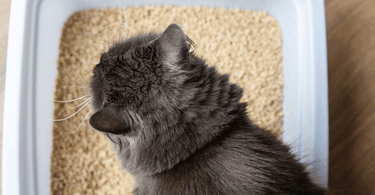If you're a cat owner, you know how important it is to keep your furry friend happy and healthy. One way to do that is by choosing the right cat litter. While clay litter has traditionally been the go-to for many cat owners, it comes with a significant downside: dust. Not only is dust messy and unpleasant to deal with, but it can also be harmful to yours and your cat's health.
That's where dust-free cat litter comes in. In this article, we'll explore the top five benefits of using a dust-free cat litter for your cat's overall well-being. From reducing respiratory problems to minimising litter tracking, you'll discover why making the switch to a dust-free option is a great choice for both you and your feline friend.
Benefits of using dust-free cat litter for your cat's respiratory health
Traditional cat litter is made with clay, which can produce a significant amount of dust when poured, scooped or simply kicked by your cat (we’ve all had a cat who absolutely loves to kick their litter everywhere). This dust can lead to respiratory problems for both you and your cat. Cats are especially susceptible to respiratory issues because they are obligate nose breathers, meaning they only breathe through their noses unless they are panting or absolutely have to. When cats are using their litter and inhale the dust from clay litter, it can irritate their nasal passages and cause breathing problems. This can be especially problematic for cats with asthma or other respiratory conditions.
Note that whilst we discuss the impact of dust in this article, symptoms of respiratory issues can also be caused by other respiratory irritants, such as smoke or allergens such as pollens in the environment. If your pet suddenly starts to sneeze violently and then develops a nasal discharge it is more likely that they have a foreign body stuck in their nose, such as a grass seeds or a small object they have sniffed up. It’s important to see your vet immediately if this happens.
By switching to a dust-free cat litter, you can significantly reduce the amount of dust in your home. Dust-free litter is made from materials like wood, recycled paper or corn, which produce little to no dust. This can help keep your cat's respiratory system healthy and reduce the risk of respiratory problems. Additionally, it can improve your air quality, making it safer and more comfortable for you and your family.
One example of a popular dust-free cat litter is Tippaws Long-lasting Clumping Litter. Made from corn and wood, this litter is free from dust and other harmful chemicals found in traditional clay litters. It's also flushable and biodegradable, making it an eco-friendly choice.
Benefits of using dust-free cat litter for your cat's digestive health
Cats are known for their cleanliness, and they spend a significant amount of time grooming themselves. When they use traditional clay litter, they often ingest small amounts of the litter when cleaning their paws. This can lead to digestive problems, such as constipation or blockages.
Dust-free cat litter is typically made from natural materials that are safe for your cat to ingest. For example, corn and wood based litter is biodegradable and easy for your cat to digest. This can help prevent digestive issues and ensure your cat stays healthy and happy. Of course, ideally your cat wouldn’t eat litter at all! There are ways in which you can train your cat not to eat litter if you have a particularly litter-loving cat for example by switching litters.. However, your cat may be eating litter for other reasons such as an eating disorder called Pica. It’s best to consult with your vet or a registered cat behaviourist to get to the root of the problem and find the right solution for your cat.
Benefits of using dust-free cat litter for your cat's mental health and happiness
Cats are creatures of habit and can be easily stressed by changes in their environment. Switching to a dust-free cat litter can help reduce your cat's stress levels and promote their mental well-being. Traditional clay litter can be heavy and uncomfortable for cats to walk on, which can be stressful for them. Additionally, dusty litter can be unpleasant for cats with sensitive noses, which can also cause stress.
Dust-free cat litter is typically lightweight and easy for cats to move around, making it more comfortable for them to use and soft on their paws. Think about it, would you rather walk barefoot on bits of soft corn and wood litter or bits of clay litter? Additionally, natural litter is often made from natural materials that are gentle on your cat's senses, reducing the risk of stress. This can help your cat feel more relaxed and comfortable in their litter tray, promoting their overall mental health and happiness.
Choosing the best dust-free cat litter for your cat
When choosing a dust-free cat litter, there are several factors to consider. First, you'll want to choose a litter made from natural materials that are safe for your cat to use. Look for litters made from materials like wood or corn. These materials are biodegradable and safe for your cat to ingest if they accidentally ingest small amounts while grooming.
You'll also want to consider how well the litter controls odour. While dust-free litter is less likely to produce odours than traditional clay litter, some litters are better at controlling odours than others. Look for litters that are tight clumping and have superior odour control like Tippaws Long-lasting Clumping Litter.
Finally, consider your cat's preferences. Some cats prefer certain textures or scents, so you may need to experiment with different types of litter to find the one your cat likes best. It;s unlikely your cat will like a scented litter so try to stay clear from these. They can irritate your cat’s nasal passages and remember a cat’s sense of smell is far greater than a human’s, so a slight floral or botanical scent for us will be extremely strong and likely unpleasant for them.
Types of dust-free cat litter
There are several types of dust-free cat litter available in the UK. Some of the most popular options include:-
Cat litter made from plant fibres such as corn and wood.
-
Clay cat litter (only some are dust-free, please check first)
-
Cat litter made from recycled paper.
-
Wood chip cat litter (only some are dust-free, please check first)
How to transition your cat to dust-free litter
If you're making the switch from traditional clay litter to dust-free litter, it's important to do so gradually. Cats are creatures of habit and can be resistant to change. Start by mixing a small amount of the new litter with the old litter and gradually increasing the amount of new litter over several days. This will allow your cat to adjust to the new texture and scent of the litter without becoming stressed or anxious.
Tips for ensuring your litter tray remains dust free
Even if you choose a dust-free litter, your litter tray can still accumulate dust just like any other object in your household. It's importance you do the following to ensure your tray remains dust free:
- Scoop regularly (1-2 times a day) to ensure clumps and poo don't attract dust
- Clean out your tray monthly if you're using a clumping cat litter and weekly if you are using a non-clumping cat litter
- Clean your litter tray with soapy water once a month
Common misconceptions about dust-free cat litter
There are several common misconceptions about dust-free cat litter that may deter some cat owners from making the switch. One of the most common misconceptions is that dust-free litter is more expensive than traditional clay litter. While some dust-free litters may be slightly more expensive, many are competitively priced with traditional clay litters. Particularly when you consider the comparative benefits and long-lasting properties of a great natural dust-free litter.
Another misconception is that dust-free litter is not as effective at controlling odours as traditional clay litter. While some dust-free litters may not be as effective at controlling odours, many are specifically formulated to absorb odours naturally. Additionally, because dust-free litter produces less dust, it's less likely to trap odours in your home.
Eco-friendly options for dust-free cat litter
If you're looking for an eco-friendly option for dust-free cat litter, there are several choices available. Litters made from natural materials like recycled paper, wood chips, or corn are biodegradable and safe for the environment. Additionally, many eco-friendly litters are flushable, making them easy to dispose of and reducing waste. Tippaws Long-lasting Clumping Litter is a great example of this.
Where can I buy dust-free cat litter?
You can buy Tippaws dust-free Long-lasting Clumping Litter online. New customers get 15% off their first order wen they subscribe to our newsletter.
Conclusion and summary of benefits of dust-free cat litter
Making the switch to a dust-free cat litter can have numerous benefits for your cat's health and happiness. By reducing the amount of dust in your home, you can help keep your cat's respiratory system healthy. Additionally, dust-free litter is safe for your cat to ingest, promoting their digestive health. It can also reduce your cat's stress levels and promote their overall mental well-being.
When choosing a dust-free cat litter, look for natural materials that are safe for your cat to use and that control odours naturally. Consider your cat's preferences when selecting a litter and transition them gradually to avoid stress or anxiety.
Finally, if you're looking for an eco-friendly option, try a wood or corn based clumping litter which are biodegradable and safe for the environment. By making the switch to a dust-free cat litter, you can promote your cat's health and happiness while also reducing your environmental impact.
Get 10% off your first order of Long-lasting Clumping Litter when you subscribe to our newsletter.

